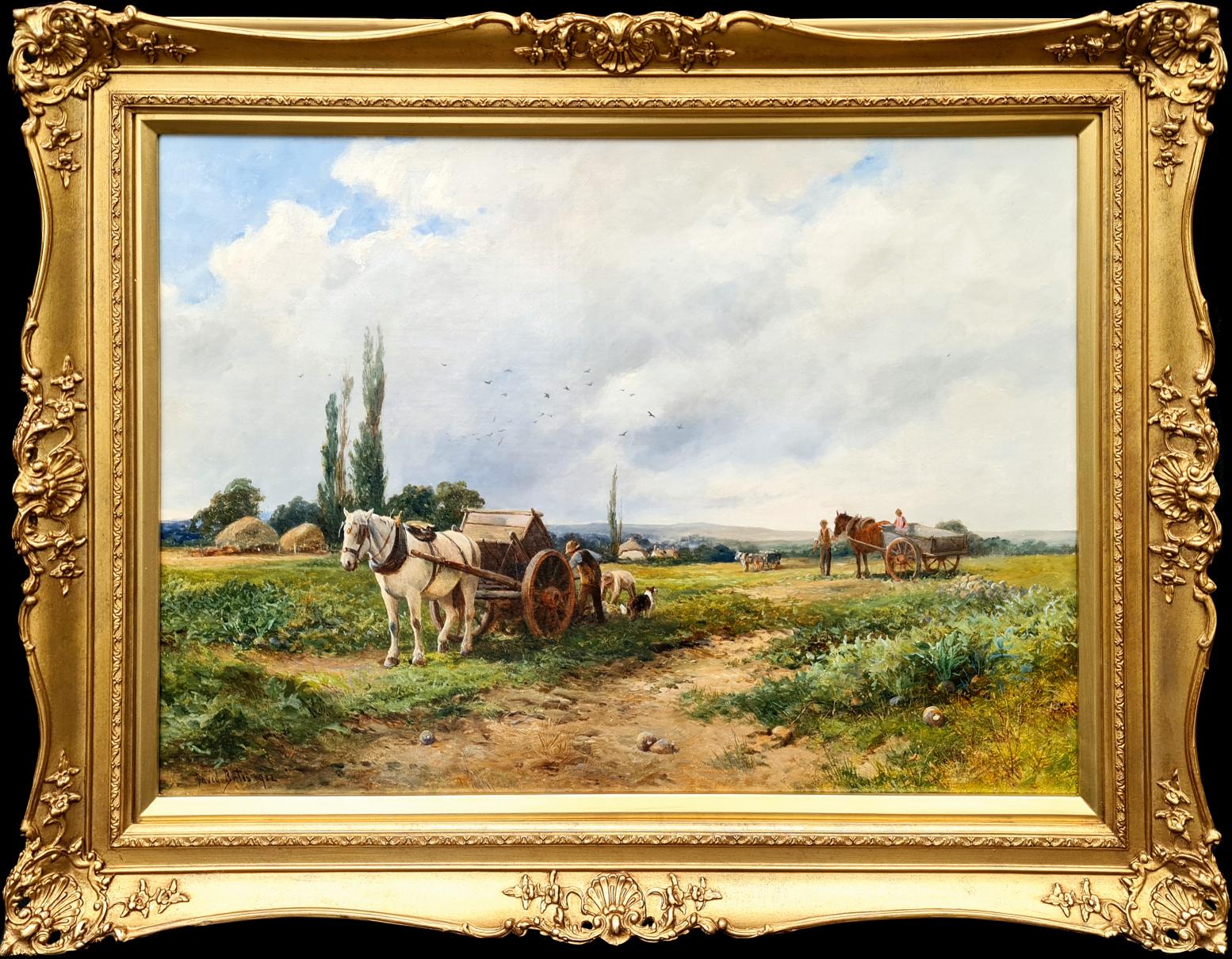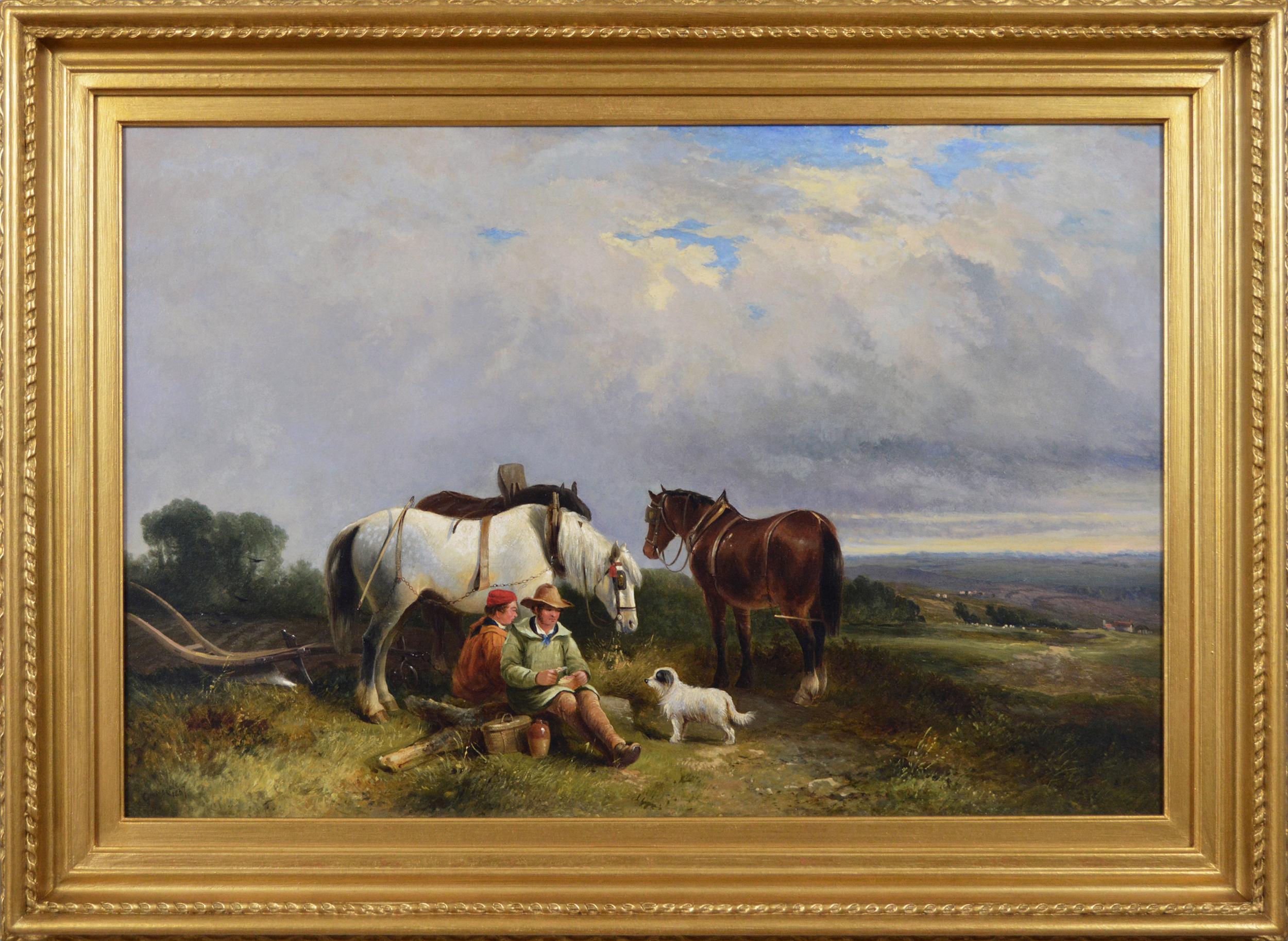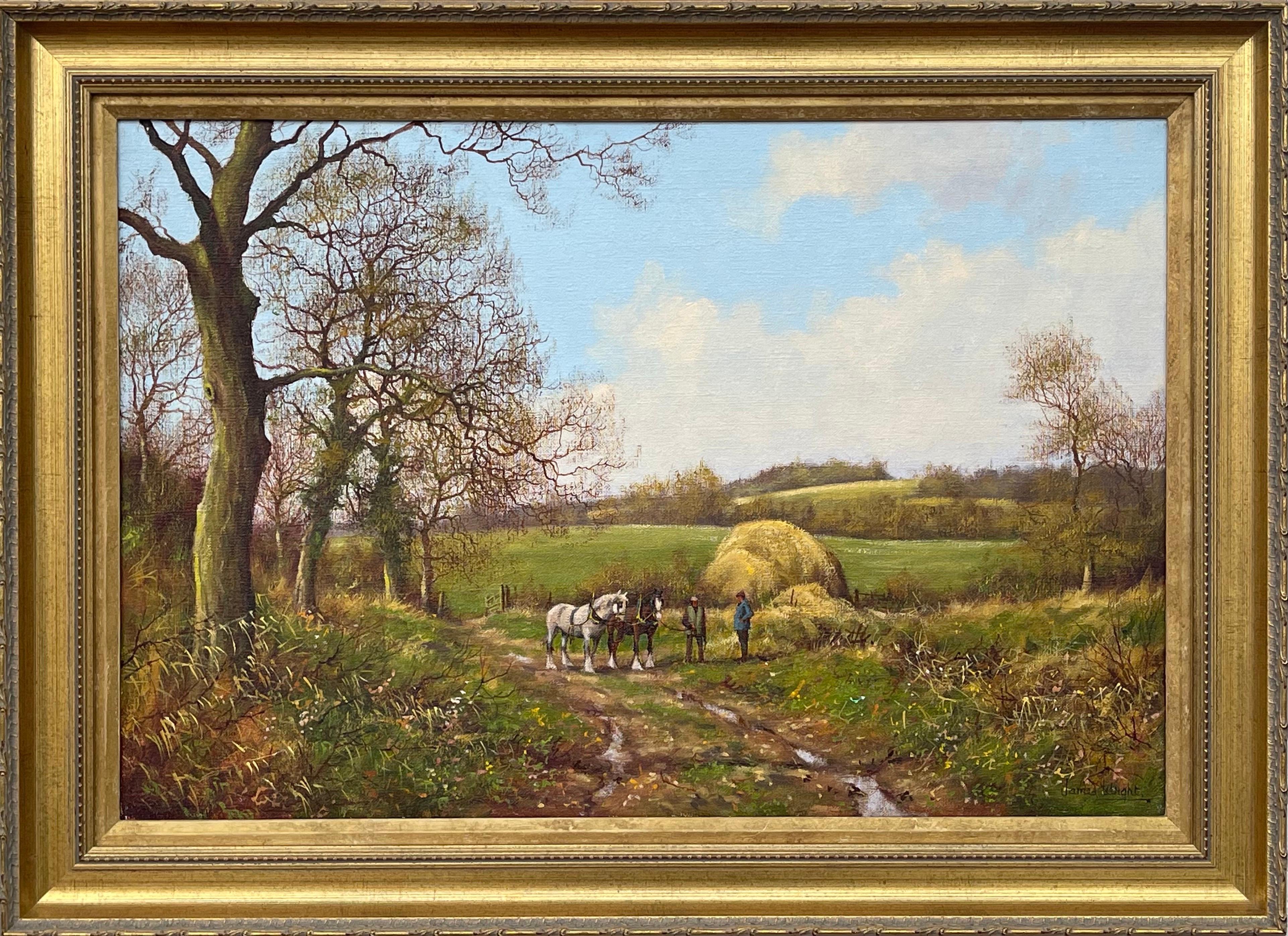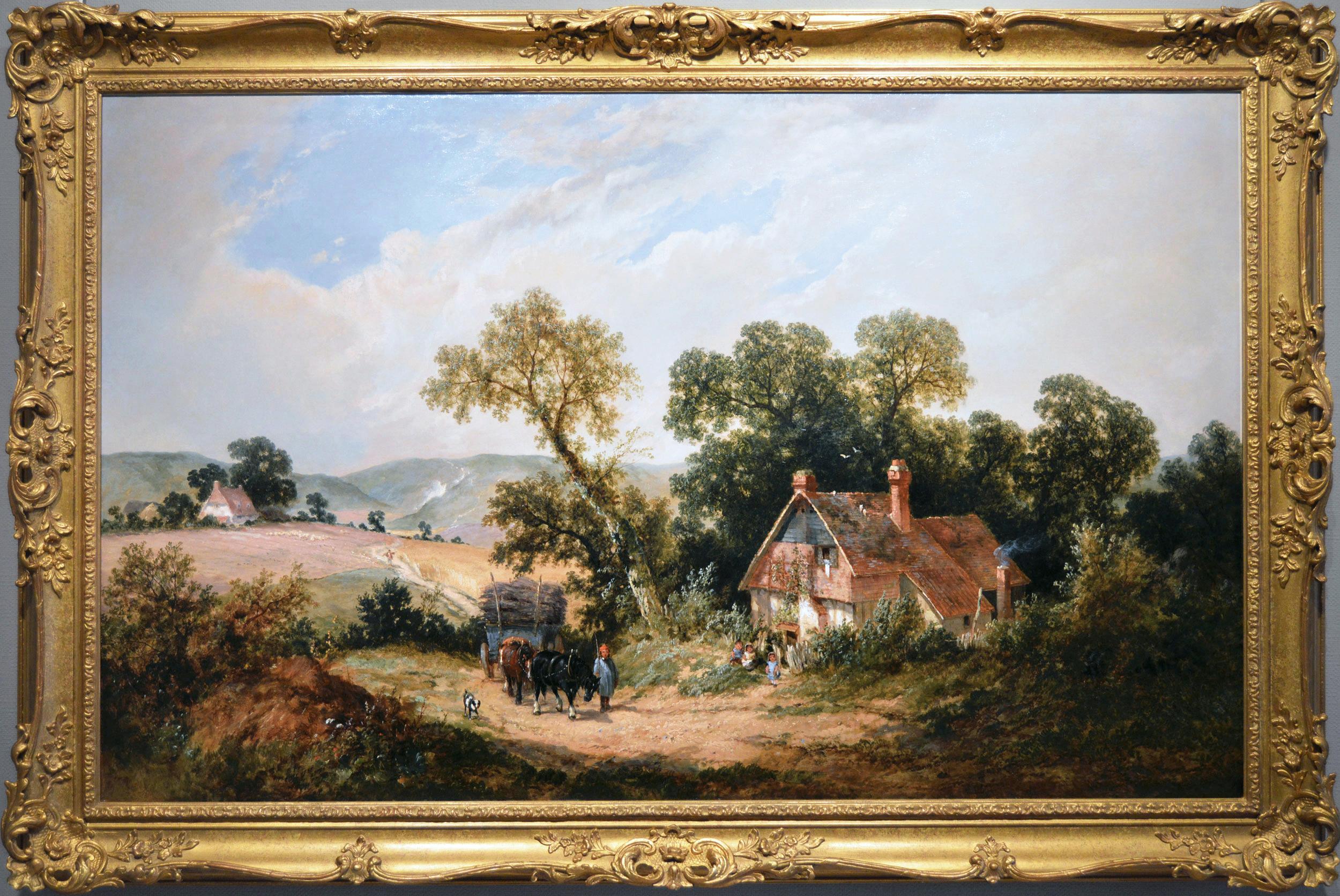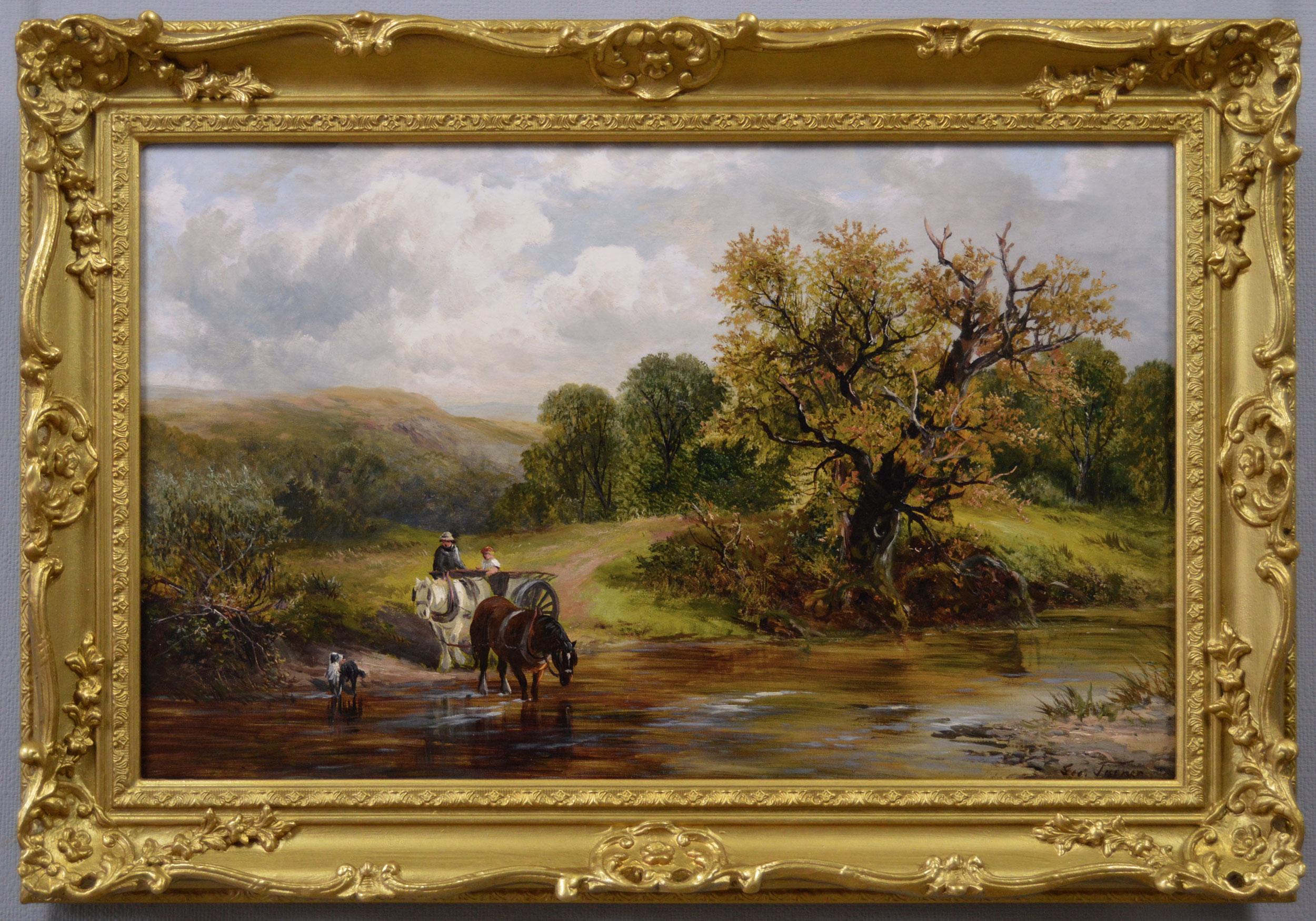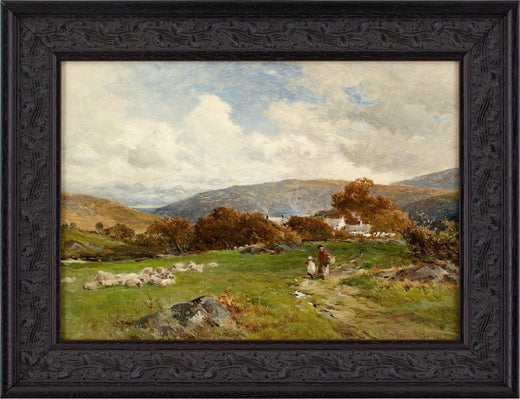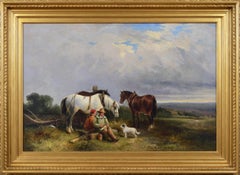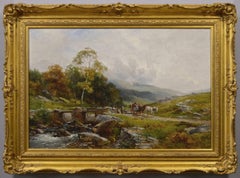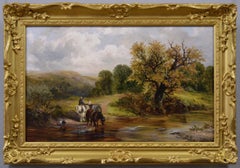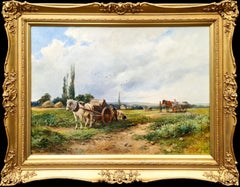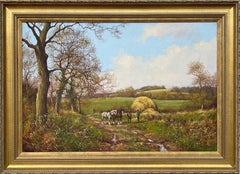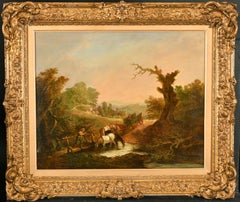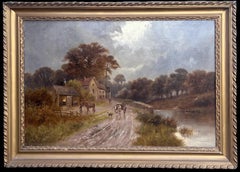Items Similar to Early 20th Century Worcestershire landscape oil painting of a plough team
Want more images or videos?
Request additional images or videos from the seller
1 of 14
David Bates b.1840Early 20th Century Worcestershire landscape oil painting of a plough team1908
1908
$5,068.28
£3,700
€4,340.79
CA$6,942.52
A$7,741.70
CHF 4,039.29
MX$94,993.57
NOK 51,413.71
SEK 48,713.37
DKK 32,396.92
Shipping
Retrieving quote...The 1stDibs Promise:
Authenticity Guarantee,
Money-Back Guarantee,
24-Hour Cancellation
About the Item
David Bates
British, (1840-1921)
The Plough Team, Bredon’s Norton
Oil on canvas, signed & dated 1908, further inscribed verso
Image size: 15.5 inches x 23.5 inches
Size including frame: 21.5 inches x 29.5 inches
A lovely landscape painting of a plough team on a country track near Bredon’s Norton by David Bates. Bredon’s Norton is a village located in the Cotswolds, on the slopes of Bredon Hill in South Worcestershire. The America women’s rights activist Victoria Woodhull Martin moved to the village in 1901 and by 1908 had set up an agricultural school for women at her Norton’s Park estate. The Antarctic explore Raymond Priestley also lived there. Although Bates was living in Surrey at the time of this painting, he would have been familiar with the area after having lived and worked in Worcestershire for some considerable time. He would have also most likely been aware of Victoria Woodhull Martin and the school.
David Bates was born in March, Cambridge in 1840 to Benjamin Bates a shoe maker and Sarah Bates. By 1851, the family had moved to Upton upon Severn in Worcestershire and from 1855 Bates became an apprentice at the Royal Worcester Porcelain Works in Worcester. There he developed his artistic talent, painting flower decorations onto vases and plates. At some point after 1861, he became a full time artist and made his debut at the Royal Academy in 1863, continuing to exhibit there until 1893. He also exhibited at the Royal Birmingham Society of Artists, Suffolk Street and the Grosvenor Gallery.
He married Elizabeth Higgs from Worcester in 1867 and they lived at Cherry Orchard, Bath Road in Worcester where their children were later born. Their second child John Bates Noel (1870-1927) became a landscape artist and their younger son David Samuel became an art agent. Around 1879 he moved to nearby Great Malvern living at Hollymount Cottage in St Ann’s Road and then at Sydenham Villa, Newtown Road. By 1891, the family had moved to Birmingham where they lived at 158 Pershore Road in Edgbaston and later Chantry Road, in Kings Norton. Sometime after 1901, he relocated to Surrey where he lived at Blandford House, Teddington. He died on 21 February 1921 at Teddington and was buried in Kingston-upon-Thames Cemetery.
Bates often travelled around Wales and the Midlands and became known for his open air painting of the area, however, he also visited other beauty spots such as the Lake District. He also spent time in North Africa painting, producing a number of works from his travels. His style and subjects were influenced by Benjamin Williams Leader and were similar to that of other members of the Birmingham School such as Joseph Thors and S.H. Baker.
Examples of his work are held in many public collections including the Canterbury Museum, Derby Museum, Dudley Museum, Hartlepool Museum, Malvern Museum, Nottingham Castle Museum, Walker Art Gallery, Wednesbury Museum, The Wilson, Wolverhampton Art Gallery and the Worcester City Museum.
Presentation: The painting is housed in a new, English made gilt frame which is in excellent condition.
Condition: As with all of our original antique oil paintings, this work is offered in ready to hang gallery condition, having been professionally cleaned, restored and revarnished.
© Benton Fine Art
- Creator:David Bates b.1840 (1840 - 1921, British)
- Creation Year:1908
- Dimensions:Height: 21.5 in (54.61 cm)Width: 29.5 in (74.93 cm)Depth: 2.5 in (6.35 cm)
- Medium:
- Period:
- Condition:
- Gallery Location:Nr Broadway, GB
- Reference Number:1stDibs: LU15629475832
David Bates b.1840
David Bates was an English landscape artist who painted in oils and watercolour. He was born in Cambridge, and from 1855 worked as a porcelain painter at the Royal Worcester porcelain works in Worcester - where he came to specialise in painting flowers. He left his employment there in 1880 to become a full-time professional painter. Bates was an "open-air" rural landscape artist, painting in the Midlands, Scotland and Wales, and abroad in Switzerland and Egypt. His work shows the influence of Benjamin Williams Leader, Joseph Thors and Samuel Henry Baker, and Bates is associated in style with the Birmingham School of artists. Bates exhibited many works at the Royal Academy, Grosvenor Gallery, Royal Society of British Artists and the New Watercolour Society in London, and at the Royal Birmingham Society of Artists. His works are currently on display in Liverpool museum, Worcester City Museum, and several other art galleries.
About the Seller
5.0
Platinum Seller
Premium sellers with a 4.7+ rating and 24-hour response times
Established in 1972
1stDibs seller since 2015
338 sales on 1stDibs
Typical response time: <1 hour
Associations
The British Antique Dealers' AssociationLAPADA - The Association of Arts & Antiques DealersInternational Confederation of Art and Antique Dealers' Associations
- ShippingRetrieving quote...Shipping from: Nr Broadway, United Kingdom
- Return Policy
Authenticity Guarantee
In the unlikely event there’s an issue with an item’s authenticity, contact us within 1 year for a full refund. DetailsMoney-Back Guarantee
If your item is not as described, is damaged in transit, or does not arrive, contact us within 7 days for a full refund. Details24-Hour Cancellation
You have a 24-hour grace period in which to reconsider your purchase, with no questions asked.Vetted Professional Sellers
Our world-class sellers must adhere to strict standards for service and quality, maintaining the integrity of our listings.Price-Match Guarantee
If you find that a seller listed the same item for a lower price elsewhere, we’ll match it.Trusted Global Delivery
Our best-in-class carrier network provides specialized shipping options worldwide, including custom delivery.More From This Seller
View All19th Century landscape genre oil painting of ploughmen with horses & a dog
By George Cole
Located in Nr Broadway, Worcestershire
George Cole
British, (1810-1883)
Waiting for a Treat
Oil on canvas, signed & dated 1857
Image size: 19.5 inches x 29.5 inches
Size including frame: 26.25 inches x 36.25 inches
A cha...
Category
19th Century Victorian Animal Paintings
Materials
Canvas, Oil
19th Century Welsh landscape oil painting of figures by the River Glaslyn
By David Bates b.1840
Located in Nr Broadway, Worcestershire
David Bates
British, (1840-1921)
Early Morning on the Glaslyn
Oil on canvas, signed & dated 1895, further inscribed verso
Image size: 23.25 inches x 35.25 inches
Size including fra...
Category
19th Century Landscape Paintings
Materials
Canvas, Oil
19th Century landscape oil painting of a horse & cart on a country track
By James Edwin Meadows
Located in Nr Broadway, Worcestershire
James Edwin Meadows
British, (1826-1893)
A Country Track
Oil on canvas, signed & dated 1861
Image size: 29.5 inches x 47.5 inches
Size including frame: 36.5 inches x 54.5 inches
A l...
Category
19th Century Victorian Landscape Paintings
Materials
Canvas, Oil
19th Century landscape oil painting of figures in a horse & cart crossing a ford
By George Turner
Located in Nr Broadway, Worcestershire
George Turner
British, (1843-1910)
Crossing the Ford
Oil on canvas, signed, further signed & inscribed verso
Image size: 15.5 inches x 25.5 inches
Size including frame: 21.5 inches...
Category
19th Century Figurative Paintings
Materials
Canvas, Oil
19th Century landscape oil painting of figures with a donkey & cart
Located in Nr Broadway, Worcestershire
Arthur Walker Redgate
British, (1860-1906)
A Wayside Chat
Oil on canvas, signed
Image size: 13.5 inches x 20.5 inches
Size including frame: 19.5...
Category
19th Century Victorian Landscape Paintings
Materials
Canvas, Oil
19th Century landscape genre oil painting of farmworkers with horses & a dog
By George Cole
Located in Nr Broadway, Worcestershire
George Cole
British, (1810-1883)
Rick Making, Lunchtime
Oil on canvas, signed & dated 1883
Image size: 23.5 inches x 35.5 inches
Size including frame: 30.5 inches x 42.5 inches
Prove...
Category
19th Century Victorian Animal Paintings
Materials
Canvas, Oil
You May Also Like
Loading the Crop
By David Bates b.1840
Located in Belgravia, London, London
Oil on canvas
Canvas size: 20 x 30 inches
Signed and dated ' 1902' lower left
Category
19th Century Landscape Paintings
Materials
Canvas, Oil
Horses with Ploughmen in the English Countryside by Realist Landscape Artist
By James Wright
Located in Preston, GB
Horse Drawn Plough with Two Horses, Ploughman and his Dog. Signed, Oil on Canvas, housed in a gilt frame, by British Landscape Artist, James Wright.
Art ...
Category
1990s Romantic Landscape Paintings
Materials
Oil, Canvas
Early English Romantic Oil Painting Farmers with Horse & Cart crossing Stream
Located in Cirencester, Gloucestershire
Horses Watering in a River,
Early 19th Century English School
oil painting on canvas, framed
framed: 23 x 28 inches
canvas: 17 x 22 inches
provenance: priv...
Category
Early 19th Century Victorian Landscape Paintings
Materials
Oil
Antique English Rural Landscape Signed Oil Painting Horse & Cart in Lane
By Henry Cooper
Located in Cirencester, Gloucestershire
The Rural Lane
Henry Cooper (British, late 19th century/ early 20th century)
signed oil painting on canvas, framed
framed: 25 x 35 inches
canvas: 20 x 30 inches
condition: very good
...
Category
Early 20th Century English School Landscape Paintings
Materials
Oil
19th century English Harvest landscape with horses, farmers, children, family
Located in Woodbury, CT
Henry Brittian Willis
English plough team at rest during harvest Summertime.
A painting by Henry Brittiam Willis capturing a 19th-century English plough team, complete with horses,...
Category
1850s Victorian Landscape Paintings
Materials
Canvas, Oil
Horse Drawn Plough with Two Horses Ploughman and Dog by British Landscape Artist
By James Wright
Located in Preston, GB
Horse Drawn Plough with Two Horses, Ploughman and his Dog. Signed, Oil on Canvas, housed in a gilt frame, by British Landscape Artist, James Wright.
Art measures 24 x 16 inches
Fram...
Category
1990s Romantic Landscape Paintings
Materials
Canvas, Oil
More Ways To Browse
20th Century Africa Paintings
David Samuels
David Antiques
Dior Brown Shoes
Worcester Royal Porcelain Plates
Royal Worcester Porcelain Flowers
John Cherry Painting
Antique Royal Worcester Plates
Antique Porcelain Shoes
Oil Spot Vase
Cherry Orchard
Cemetery Vase
Bat Porcelain
Martin Cottage Painting
Noel Martin
Baker Canterbury
Diana Of The Hunt Painting
Fiona Pearce
